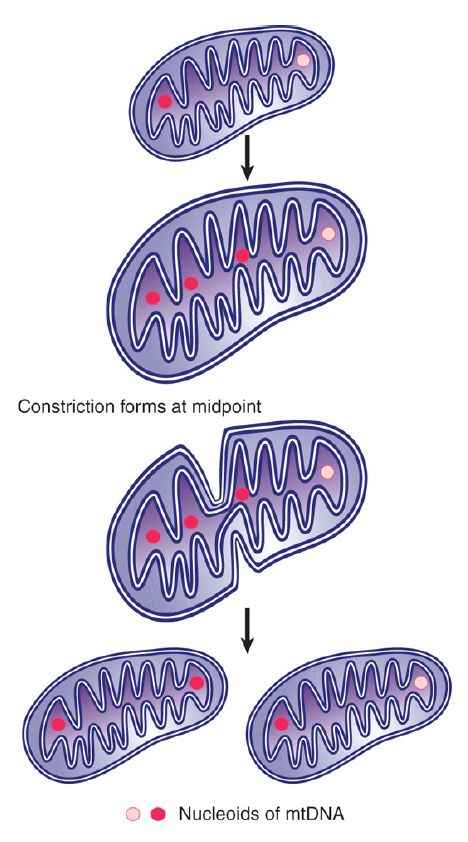
How Do Mitochondria Replicate and Segregate
 المؤلف:
JOCELYN E. KREBS, ELLIOTT S. GOLDSTEIN and STEPHEN T. KILPATRICK
المؤلف:
JOCELYN E. KREBS, ELLIOTT S. GOLDSTEIN and STEPHEN T. KILPATRICK
 المصدر:
LEWIN’S GENES XII
المصدر:
LEWIN’S GENES XII
 الجزء والصفحة:
الجزء والصفحة:
 10-4-2021
10-4-2021
 2665
2665
How Do Mitochondria Replicate and Segregate?
KEY CONCEPTS
- mtDNA replication and segregation to daughter mitochondria is stochastic.
- Mitochondrial segregation to daughter cells is also stochastic.
Mitochondria must be duplicated during the cell cycle and segregated to the daughter cells. Researchers understand some of the mechanics of this process, but not its regulation.
At each stage in the duplication of mitochondria—DNA replication, DNA segregation to duplicated mitochondria, and organelle segregation to daughter cells—the process appears to be stochastic, governed by a random distribution of each copy. The theory of distribution in this case is analogous to that of multicopy bacterial plasmids, with the same conclusion that about 10 copies are required to ensure that each daughter gains at least one copy.
When there are mtDNAs with allelic variations in the same cell, called heteroplasmy (either because of inheritance from different parents or because of mutation), the stochastic distribution may generate cells that have only one of the alleles.
Replication of mtDNA might be stochastic because there is no control over which particular copies are replicated, so that in any cycle some mtDNA molecules might replicate more times than others. The total number of copies of the genome might be controlled by titrating mass in a way similar to that of bacteria .
A mitochondrion divides by developing a ring around the organelle that constricts to pinch it into two halves. The mechanism is similar in principle to that involved in bacterial division. The apparatus that is used in plant cell mitochondria is similar to that used in bacteria and uses a homolog of the bacterial protein FtsZ . The molecular apparatus is different in animal cell mitochondria and uses the protein dynamin, which is involved in formation of membranous vesicles. An individual organelle may have more than one copy of its genome.
Researchers do not know whether there is a partition mechanism for segregating mtDNA molecules within the mitochondrion, or whether they are simply inherited by daughter mitochondria according to which half of the mitochondrion in which they happen to lie. FIGURE 1. shows that the combination of replication and segregation mechanisms can result in a stochastic assignment of DNA to each of the copies; that is, so that the distribution of mitochondrial genomes to daughter mitochondria does not depend on their parental origins.

FIGURE 1. Mitochondrial DNA replicates by increasing the number of genomes in proportion to mitochondrial mass, but without ensuring that each genome replicates the same number of times. This can lead to changes in the representation of alleles in the daughter mitochondria.
The assignment of mitochondria to daughter cells at mitosis also appears to be random. Indeed, it was the observation of somatic variation in plants that first suggested the existence of genes that could be lost from one of the daughter cells because they were not inherited according to Mendel′s laws .
In some situations a mitochondrion has both paternal and maternal alleles. This has two requirements: that both parents provide alleles to the zygote (which of course is not the case when there is maternal inheritance; see the chapter titled The Content of the Genome), and that the parental alleles are found in the same mitochondrion. For this to happen, parental mitochondria must have fused.
The size of the individual mitochondrion might not be precisely defined. Indeed, there is a continuing question about whether an individual mitochondrion represents a unique and discrete copy of the organelle or whether it is in a dynamic flux in which it can fuse with other mitochondria. Researchers know that mitochondria can fuse in yeast, because recombination between mtDNAs can occur after two haploid yeast strains have mated to produce a diploid strain. This implies that the two mtDNAs must have been exposed to one another in the same mitochondrial compartment.
Researchers have made attempts to test for the occurrence of similar events in animal cells by looking for complementation between alleles after two cells have been fused, but the results are not clear.
 الاكثر قراءة في مواضيع عامة في الاحياء الجزيئي
الاكثر قراءة في مواضيع عامة في الاحياء الجزيئي
 اخر الاخبار
اخر الاخبار
اخبار العتبة العباسية المقدسة


